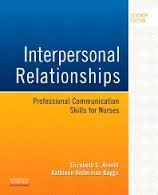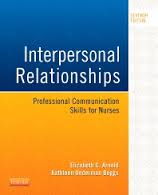Test Bank Interpersonal Relationships 7th Edition Boggs Arnold

Description:
Chapter 2: Professional Guides for Nursing Communication
Arnold: Interpersonal Relationships, 7th Edition
MULTIPLE CHOICE
1. The nurse demonstrates effective communication by ensuring all of the following except
a. two-way exchange of information among clients and health providers.
b. making sure that unilateral information is exchanged between clients and nurses.
c. making sure that the expectations and responsibilities of all are clearly understood.
d. recognizing that effective communication is an active process for all involved.
ANS: B
Effective communication is defined as a two-way exchange of information among clients and health providers ensuring that the expectations and responsibilities of all are clearly understood. It is an active process for all involved.
DIF: Cognitive Level: Knowledge REF: p. 23
TOP: Step of the Nursing Process: All phases
MSC: Client Needs: Management of Care
2. A preoperative assessment shows that a client’s hemoglobin level is dropping. The anesthetist orders 3 units of blood to be administered. The nurse administers the first unit before discovering that the client is a Jehovah’s Witness, as documented in the record. This is an example of
a. professional conduct.
b. a negligent act.
c. physical abuse.
d. breaching client confidentiality.
ANS: B
The nurse was negligent by not checking the record and by failure to obtain written consent from the client for the procedure. This is an example of misconduct, not professional conduct. The nurse did not intend to physically harm the patient. The nurse did not breach client confidentiality.
DIF: Cognitive Level: Application REF: pp. 28-29
TOP: Step of the Nursing Process: All phases
MSC: Client Needs: Management of Care
3. Which of the following is a violation of client confidentiality? Reporting
a. certain communicable diseases.
b. child abuse.
c. gunshot wounds.
d. client data to a colleague in a nonprofessional setting.
ANS: D
Releasing information to people not directly involved in the client’s care is a breach of confidentiality. Certain communicable or sexually transmitted diseases, child and elder abuse, and the potential for serious harm to another individual are considered exceptions to sharing of confidential information.
DIF: Cognitive Level: Knowledge REF: p. 37
TOP: Step of the Nursing Process: All phases
MSC: Client Needs: Management of Care
4. A 16-year-old trauma victim arrives in the emergency department with a life-threatening condition and requires emergency surgery. The nurse knows that
a. a parent/guardian must give consent.
b. the client can give consent if she provides proof of emancipation.
c. the client must first be evaluated for competency before obtaining consent.
d. surgery can be performed without consent.
ANS: D
Surgery can be performed without consent because it is a life-threatening emergency. Normally parents or a guardian must give consent, but in a life-threatening emergency medical care can be administered without consent. Providing proof of emancipation is not necessary in a life-threatening situation. The client does not need to first be evaluated for competency in a life-threatening situation.
DIF: Cognitive Level: Application REF: p. 38
TOP: Step of the Nursing Process: All phases
MSC: Client Needs: Management of Care
5. In regard to informed consent, which of the following statements is true?
a. Only legally incompetent adults can give consent.
b. Only parents can give consent for minor children.
c. It is not required that the client be told about costs and alternatives to treatment.
d. Consent must be voluntary.
ANS: D
For legal consent to be valid, it must be voluntary. Only legally competent adults can give consent. Parents or legal guardians can give consent for minor children. Clients must have full disclosure about risks/benefits, including costs and alternatives.
DIF: Cognitive Level: Knowledge REF: p. 37
TOP: Step of the Nursing Process: All phases
MSC: Client Needs: Management of Care
6. The client has a living will in which he states he does not want to be kept alive by artificial means. The client’s family wants to disregard the client’s wishes and have him maintained on artificial life support. The most appropriate initial course of action for the nurse would be to
a. tell the family that they have no legal rights.
b. tell the family that they have the right to override the living will because the patient cannot speak.
c. report the situation to the hospital ethics committee.
d. allow the family to verbalize their feelings and concerns, while maintaining the role of client advocate.
ANS: D
Allowing the family to verbalize their feelings and concerns is the most appropriate action at the time to help the family deal with their loss and come to terms with their family member’s wishes. Telling the family that they have no legal rights would not be supportive and might create hostility. The family does not have the right to override a living will. It is not the most appropriate initial course of action to report the situation to the hospital ethics committee. According to the American Nurses Association Code of Ethics for Nurses, the nurse promotes, advocates for, and strives to protect the health, safety, and rights of the patient.
DIF: Cognitive Level: Analysis REF: p. 27
TOP: Step of the Nursing Process: Implementation
MSC: Client Needs: Management of Care
7. The nurse collects both objective and subjective data. An example of subjective data is
a. BP 140/80.
b. skin color jaundiced.
c. “I have a headache.”
d. history of seizures.
ANS: C
Subjective data refers to the client’s perception of data and what the client or family says about the data. Objective data refers to data that are directly observable or verifiable through physical examination or tests. Blood pressure recording is objective. Jaundiced skin color observation by the nurse is objective data. A history of seizures is objective data.
DIF: Cognitive Level: Knowledge REF: p. 33
TOP: Step of the Nursing Process: Assessment
MSC: Client Needs: Physiological Integrity
8. The nurse observes a client pacing the floor. The nurse validates an inference when speaking to the client by stating,
a. “You are anxious, so let’s talk about it.”
b. “Let’s try some deep breathing to help you relax.”
c. “You seem anxious. Will you tell me what is going on?”
d. “Clients who pace usually need to talk to a physician. Should I call yours?”
ANS: C
The nurse has inferred that the client is anxious but needs to ask further questions to validate the information. A nurse should not make assumptions without first confirming that the inference is correct. Deep breathing exercise is an intervention; it is not validating an inference.
DIF: Cognitive Level: Application REF: p. 33
TOP: Step of the Nursing Process: Assessment
MSC: Client Needs: Psychosocial Integrity
9. A client who is scheduled for a bilateral inguinal hernia repair the next day is observed pacing the unit. After validating that the client is anxious about his upcoming surgery because he is afraid of pain, a relevant nursing diagnosis would be
a. anxiety related to surgery.
b. pain related to anxiety about surgery as evidenced by pacing.
c. anxiety related to fear of postoperative pain as evidenced by pacing.
d. pacing related to fear of postoperative pain.
ANS: C
Anxiety is the problem to be addressed. Related to connects the problem to the etiology (fear of pain). The third part of the statement identifies the clinical evidence (pacing) that supports the diagnosis. There are three parts to a nursing diagnosis, and the anxiety is related specifically to fear of pain after surgery. The problem to be addressed is the anxiety, not the pain, at this time. “Pacing related to fear of postoperative pain” contains only two parts to this statement. Pacing is the evidence, not the problem.
DIF: Cognitive Level: Application REF: p. 33
TOP: Step of the Nursing Process: Nursing Diagnosis
MSC: Client Needs: Management of Care
10. Which of the following is an outcome for a client with a broken leg?
a. Client will develop an ambulation program within 1 month.
b. Encourage client to ambulate with cast using crutches.
c. Client asks, “When will I walk again?”
d. Client experiences alteration in mobility related to a broken leg.
ANS: A
Outcomes are goals that are measurable, achievable, and client centered. Ambulation is a nursing intervention. A question from the client is not an outcome; it is a question. “Client experiences alteration in mobility related to a broken leg” is part of a nursing diagnosis.
DIF: Cognitive Level: Application REF: pp. 34-35
TOP: Step of the Nursing Process: Outcome Identification
MSC: Client Needs: Physiological Integrity
11. The nurse is teaching a client who is alert and oriented about the drug warfarin. When teaching the client about this drug, the nurse emphasizes the need to be consistent with Vitamin K intake, which is found primarily in green leafy vegetables. When the client’s spouse comes to visit, the client states, “I can no longer consume green leafy vegetables.” This is an example of what type of failure caused by a communication problem?
a. System failure
b. Reception failure
c. Transmission failure
d. Global aphasia
ANS: B
Communication problems occur when there are failures in one or more categories: the system, the transmission, or in the reception. Reception failures occur when channels exist and necessary information is sent, but the recipient misinterprets the message. System failures occur when the necessary channels of communication are absent or not functioning. Transmission failures occur when the channels exist but the message is never sent or is not clearly sent.
DIF: Cognitive Level: Analysis REF: p. 23
TOP: Step of the Nursing Process: Implementation
MSC: Client Needs: Psychosocial Integrity
12. When setting goals with a client, the nurse demonstrates which step of the nursing process?
a. Assessment
b. Planning
c. Implementation
d. Evaluation
ANS: B
Outcome identification occurs during the planning phase. Goals are identified during planning, not assessment. Nursing interventions are performed during the implementation phase. During evaluation, goal achievement is evaluated.
DIF: Cognitive Level: Knowledge REF: p. 35
TOP: Step of the Nursing Process: Outcome Identification and Planning
MSC: Client Needs: Management of Care
13. When the nurse identifies a health problem or alteration in a client’s health status that requires a nursing intervention, the nurse is performing which step of the nursing process?
a. Diagnosis
b. Planning
c. Intervention
d. Evaluation
ANS: A
The nursing diagnosis consists of three parts: (1) problem, (2) etiology, and (3) evidence. The problem is a statement identifying a health problem or alteration in a client’s health status requiring nursing intervention. Planning occurs after problem identification. Interventions occur during implementation. The effectiveness of the interventions is evaluated in the evaluation phase.
DIF: Cognitive Level: Knowledge REF: p. 33
TOP: Step of the Nursing Process: Diagnosis
MSC: Client Needs: Management of Care
14. When evaluating the client’s progress toward goal achievement, the nurse should ask which of the following questions?
a. “Did the client tell the truth?”
b. “Were the goals realistic?”
c. “Did the physician diagnose the client’s condition correctly?”
d. “Was the length of stay too short?”
ANS: B
The goals need to be realistic and achievable in the time frame allotted for the interventions to be effective. Validation of information occurs in the assessment phase. Medical diagnosis is not part of the nursing process. The nurse needs to work within the time frame allotted.
DIF: Cognitive Level: Comprehension REF: p. 34
TOP: Step of the Nursing Process: Evaluation
MSC: Client Needs: Management of Care
15. The plan of care serves as the structural framework for
a. maintaining confidentiality.
b. attaining self-actualization.
c. maintaining therapeutic communication.
d. providing safe, high-quality care.
ANS: D
The plan of care plan serves as the structural framework for providing safe, high-quality care. Its purpose is to provide continuity and supply a basis for interventions and documentation of client progress. Each plan of care should be individualized to reflect client values, clinical needs, and preferences. Confidentiality is defined as providing only the information needed to provide care for the client to other health professionals who are directly involved in the care of the client. The nurse can use Maslow’s hierarchy of needs to prioritize goals and objectives. Therapeutic communication helps the nurse use the nursing process.
DIF: Cognitive Level: Comprehension REF: p. 35
TOP: Step of the Nursing Process: All phases
MSC: Client Needs: Management of Care
16. The nurse is caring for a client whose health has suddenly worsened. The nurse calls the health care provider. What is the best example of the nurse communicating to the health care provider using the situation part of SBAR communication?
a. “The patient has developed dyspnea with audible crackles in the lungs bilaterally; oxygen saturation is 86% on room air.”
b. “The patient has chronic obstructive pulmonary disease due to a long-term history of smoking.”
c. “I am concerned that the patient is exhibiting signs of a pulmonary embolus due to a sudden drop in oxygenation.”
d. “I would like for you to order a STAT chest x-ray because the patient has suddenly developed shortness of breath with hypoxia.”
ANS: A
Situation: What is going on with the client? Background: What is key information/context? Assessment: What do I think the problem is? Recommendation: What do I want to be done?
DIF: Cognitive Level: Analysis REF: p. 24
TOP: Step of the Nursing Process: All phases of the nursing process
MSC: Client Needs: Management of Care
17. During a routine visit, the nurse notes that a child has several bruises at various stages of healing. The child reports having fallen down. Failure to report these findings is an example of
a. negligence.
b. reasonable prudence.
c. maintenance of confidentiality.
d. HIPAA regulation.
ANS: A
Failing to report suspected physical or sexual child abuse is an example of a negligent act. Reasonable prudence is a nursing action that a reasonably prudent nurse would perform. In a situation where a child has several bruises, confidentiality must be breached. HIPAA regulations protect the privacy of client records.
DIF: Cognitive Level: Application REF: p. 37
TOP: Step of the Nursing Process: Implementation
MSC: Client Needs: Management of Care
MULTIPLE RESPONSE
1. When practicing effective and correct communication, the nurse should (Select all that apply.)
a. speak in a clear voice.
b. be concise when providing client education.
c. be concrete when communicating with clients.
d. focus entirely on abstract communication techniques with clients.
e. ensure that communication with clients is complete.
f. provide courteous communication when interacting with clients.
ANS: A, B, C, E, F
Effective and correct communication is: clear, concise, concrete, complete, and courteous.
DIF: Cognitive Level: Analysis REF: p. 23
TOP: Step of the Nursing Process: All phases
MSC: Client Needs: Psychosocial Integrity
Product details:
- ISBN-10 : 0323242812
- ISBN-13 : 978-0323242813
- Author: Kathleen Underman Boggs
People also search:
interpersonal relationships 7th edition free pdf
interpersonal relationship list
5 types of interpersonal relationship
interpersonal relationship examples
what are the 4 types of interpersonal relationships





